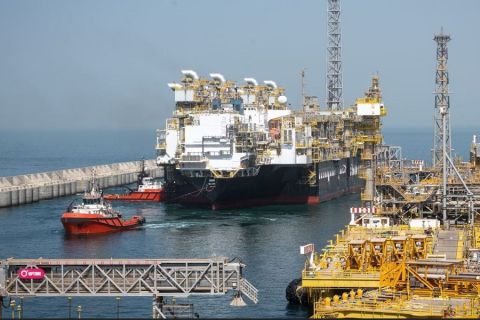Drilling in the Pattani Basin presents many challenges. The offshore gas reserves in the Gulf of Thailand stretch as deep as 3,354 m (11,000 ft) true vertical depth, and geothermal gradients can be as high as 3.2 degrees per 100 ft (30 m). Operators like Chevron Thailand originally began developing the reserves in the northern part of the Gulf, where bottomhole temperatures are lower; however, these easier-to-drill wells were quickly depleted.
The deep gas reserves in the Gulf of Thailand are notoriously ephemeral—they produce a large volume immediately upon being tapped but quickly drop off. Due to the speed required to maximize the profitability of these operations, drillers generally need to use aggressive strategies that increase rpm and ROP. Precise formation evaluation and real-time geosteering data are therefore critical to effective well placement and completion in this region.
Meeting field demands
Most commercial MWD and LWD tools are rated to 175 C (347 F) and 30,000 psi (206.8 MPa). While planning to drill the southern portions of the Pattani Basin—where bottomhole temperatures frequently reach 200 C (392 F)—Chevron Thailand recognized that it would need tools with a higher capability than anything currently available on the market. Chevron Thailand had worked with Weatherford previously, and the operator approached Weatherford about a potential partnership.
In May 2014 Chevron and Weatherford entered into a joint agreement to collaboratively develop a suite of tools capable of providing LWD and geosteering data in the Gulf of Thailand’s most extreme fields. After nine months of research and field tests, Weatherford and Chevron produced what they have branded the Heat-Wave Extreme service (HEX).
The HEX suite currently includes an HP/HT version of the Weatherford HEL MWD system, which houses directional sensors for geosteering as well as gamma-ray and bore/annular pressure (BAP) sensors and a neutron porosity tool. Additional high-temperature-rated sensors are under development and will be added to the HEX suite upon completion. All equipment used as part of the service has been specially calibrated to withstand temperatures up to 200 C and pressures up to 30,000 psi for up to 200 hours at a time.

Producing real results
The first field use of the HEX service occurred in February 2015. Weatherford Drilling Services personnel deployed the HEX tools in 22 HP/HT offshore wells operated by Chevron Thailand. The high-temperature-rated sensors in the HEX assembly
operated for 1,650 hours, gathering real-time and recorded data throughout the operation. The real-time directional sonde data enabled the driller to efficiently steer the wells to total depth, often in a single run. The driller also was able to closely monitor drilling mechanics using real-time data from the BAP sensor. Chevron and Weatherford jointly reviewed the recorded data from the directional and BAP sensors to improve the safety and efficiency of subsequent runs. Additionally, the neutron porosity and gamma-ray measurements provided essential formation evaluation data.
On top of reducing the total number of trips by LWD, Chevron experienced time savings by minimizing the need for temperature mitigation. When using tools in environments that test the limits of the temperatures and pressures for which these were designed, operators frequently pull the drillstring partially or completely out of the hole to allow the tools to cool before returning downhole to complete the job.
Over the course of the entire 22-well operation, Weatherford drilled 45,806 m (150,282 ft)—including 5,744 m (18,844 ft) in which temperatures exceeded 175 C—without having to make any dedicated trips to “cool” the bottomhole assembly.
The third way in which the HEX service provided time savings was by enabling Weatherford to maintain optimal drilling parameters. Because of the durability of the tools in the HEX assembly and the ability to monitor downhole conditions in real time, the team did not need to reduce rpm or alter the ROP when drilling through HP/HT sections.
Through the combination of factors detailed above, the HEX service enabled Weatherford to drill and log each well in an average of 6.2 days. The team completed the entire 22-well drilling campaign in 25 runs and 1,218 drilling hours with zero tool failures, zero blind runs, zero safety incidents and zero nonproductive time. Taking into account rig time as well as equipment and personnel costs, the HEX service saved Chevron about $4 million.
Continuing innovations, ongoing value
The value of this joint agreement goes far beyond savings in a single well or field. “Our joint development with Chevron Thailand is a prime example of Weatherford innovating to meet the needs of the marketplace,” said Etienne Roux, vice president of drilling services at Weatherford. “When operators experience new or unusual challenges that exceed the capabilities of our existing offerings, we use the opportunity to take our technology to the next level. We hope to deploy the full HEX suite in diverse HP/HT fields worldwide to help our clients maximize the value of their most complex assets.”
Weatherford and Chevron are currently engaged in Phase 2 of the joint agreement, developing additional tools to enable full triple-combo LWD capabilities in extreme environments. Prototypes for these complementary tools are being designed, and field trials are expected to begin in third-quarter 2016.

Recommended Reading
Tech Trends: Halliburton’s Carbon Capturing Cement Solution
2024-02-20 - Halliburton’s new CorrosaLock cement solution provides chemical resistance to CO2 and minimizes the impact of cyclic loading on the cement barrier.
BP: Gimi FLNG Vessel Arrival Marks GTA Project Milestone
2024-02-15 - The BP-operated Greater Tortue Ahmeyim project on the Mauritania and Senegal maritime border is expected to produce 2.3 million tonnes per annum during it’s initial phase.
Help Wanted (Badly): Attracting Workers to Energy is Becoming Difficult
2024-03-27 - Attracting workers to the energy industry is becoming a difficult job, despite forecasted growth in the industry.
Deepwater Roundup 2024: Offshore Australasia, Surrounding Areas
2024-04-09 - Projects in Australia and Asia are progressing in part two of Hart Energy's 2024 Deepwater Roundup. Deepwater projects in Vietnam and Australia look to yield high reserves, while a project offshore Malaysia looks to will be developed by an solar panel powered FPSO.
Technip Energies Wins Marsa LNG Contract
2024-04-22 - Technip Energies contract, which will will cover the EPC of a natural gas liquefaction train for TotalEnergies, is valued between $532 million and $1.1 billion.





